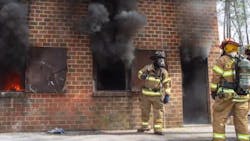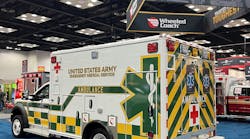Firefighters train for hundreds of hours each year to keep their skills sharp, but the opportunities for learning about how to better fight fires are limited in Orange County.
A federal grant to buy a flexible training center could change that, if the Chapel Hill Town Council agrees to put it on a town-owned site on Millhouse Road. The council heard about the project Wednesday and continued a public hearing and possible vote to June 12.
The council also will have to rezone the 10-acre tract to allow for a public service facility. The site is between Chapel Hill Transit and the town’s public works facility and is just right, officials said — about two acres, flat, centrally located, close to city water and economical.
The town’s Planning Commission recommended the council approve both the rezoning and the training center.
The four-story, $360,000 facility could stay on Millhouse Road for at least five years, until a permanent site is found, Chapel Hill Fire Chief Matt Sullivan said. Besides volunteer and professional firefighters, the center also could provide training space for the Chapel Hill High School Firefighting Academy, Durham Tech’s Fire Academy, and local law enforcement and emergency services, he said.
But it has to be delivered and installed by September to meet the grant requirements.
Chapel Hill fire equipment operator Phillip Nasseri, who also is chief of the White Cross Volunteer Fire Department, applied for the grant after becoming frustrated that the county had not had a good training facility for over 15 years. County conversations about a regional site had not gotten very far, he told the council.
The $330,000 grant from FEMA’s Assistance to Firefighters program includes a 10% local match. The county is providing $56,000 from its emergency services budget to fill the gap, Nasseri said. The work to get the site ready is extra, he said, but should be minimal.
His firefighters at White Cross have used a similar Alamance County center in past years to get their required certifications, Nasseri said. White Cross also practices live burns on a few donated houses each year, he said, but environmental concerns make that more difficult.
“To hear the fire burning, hear the noise before it flashes off, all of these are very distinct characteristics that your senses pick up on,” Nasseri said.
“There’s no way to replicate that other than actually having to burn something,” he said. “That’s the problem we’re having in the fire service as a whole. Our fires are decreasing in number, but the injuries and deaths to firefighters are increasing, and the deaths and injuries to civilians are increasing.”
Clean and flexible
Chapel Hill has a fire training tower built in the early 1980s at Station 4 on Weaver Dairy Road Extension. A separate burn building was added in 1987 to simulate house fires and rescues. They used to light real fires, Sullivan said, but it’s not possible anymore and the upper floor has deteriorated from years of heat.
“You can’t put pallets in (the current building) and light them on fire and do actual firefighting,” he said. “You have to have smoke and simulate a fire.”
The new training center will provide multiple opportunities, from navigating stairs, ladders and small, dark spaces to rappelling down the side of a building and breaching doors and windows. Made from prefabricated shipping containers, the center can be assembled in less than a week, has separate, insulated burn chambers and can be reconfigured to offer a different training scenario every time.
It will burn only plain wood pallets and clean straw, Sullivan said, producing smoke or smells akin to a woodstove. Adding a rain garden to the Millhouse Road site could filter any soot and water runoff.
Sullivan noted that the Station 4 tower was once isolated in northern Chapel Hill, but they had to adjust as neighbors moved in.
“As the neighborhoods have been built around us, trying to be good neighbors, we have had to change some of the ways we train — the smoke, the noise, the lights — when the leaves are down, you can see some of the houses and the apartments here,” Sullivan said.
The county also will get a simulator, Nasseri said, that allows firefighters to safely learn the signs of a flashover — the point at which all flammable materials in a room appear to ignite simultaneously — and how to respond.
The training center could be used three or four times a month and has a 15- to 20-year lifespan, Sullivan said; damaged burn boxes could be replaced sooner. It’s easy to switch out damaged boxes, add new ones, or unbolt the whole thing and relocate it, he said.
The county’s 10 rural and urban fire departments would chip in to maintain the structure and the site, Nasseri said.
Training required
Local officials have talked for several years about a centralized emergency training center. Professional firefighters must train for 240 hours each year to get Insurance Services Office certification, which can improve a department’s risk rating and lower the cost for home fire insurance.
North Carolina requires volunteers to have a minimum of 36 training hours, but many meet up to half of the professional requirements, Nasseri said. At White Cross, volunteers train up to four hours each week and meet monthly for certification classes, he said.
But there are fewer volunteers, pushing most departments to part-time staff. Caldwell Volunteer Fire Department is the only Orange County station that does not have paid staff, Nasseri said.
At White Cross, part-time staff works 24 hours on Saturdays and Sundays, he said, and many of the 40 volunteers work 48 hours at the station each month. Roughly a dozen live close enough to respond regularly to calls, he said. The department is asking for a one-cent increase in the district’s fire tax to add more paid staff during the week, he said.
“We have all these volunteers that do it for free and save all these millions of dollars in tax (money). You’ve got to have some avenues to train them,” Nasseri said.
Sullivan, in an interview, advocated for multiple county sites, each with a different type of training.
“That way, you don’t have to come to one place to do everything,” he said. “You can do the new training prop we have coming in for one thing, you could use a drill tower somewhere else, and you could do pump training, a lot of the rural departments have to do shuttles with water, so you could give a menu of resources that you could tap in the different places.”
The county has considered two permanent sites — Durham Tech’s Orange County campus in Hillsborough and the Blackwood Farm Park on N.C. 86.
Durham Tech, which has a new Fire Academy program, is interested in contributing financially to the training center and using it, Sullivan said, but the Hillsborough campus is not ideal, because it is beside the Waterstone neighborhood and the ground is rocky.
Blackwood Farm Park would be a good, central location, Nasseri said, but the county hasn’t made a decision yet. Sullivan also noted a possible site in Hillsborough near the state’s Orange Correctional Center on Churton Street.
———
©2019 The Herald-Sun (Durham, N.C.)
Visit The Herald-Sun (Durham, N.C.) at www.heraldsun.com
Distributed by Tribune Content Agency, LLC.






